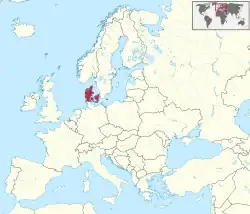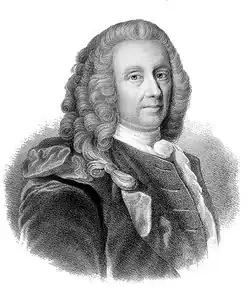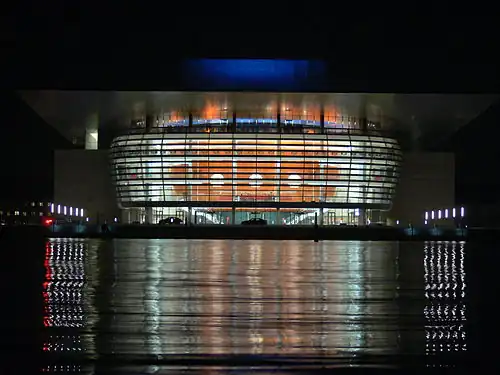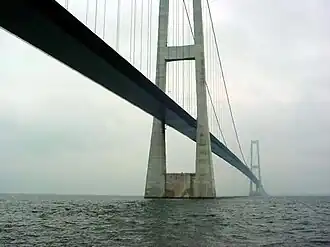Portal:Denmark
Welcome to the Denmark Portal! | ||||

|

|

| |
Denmark is the smallest and southernmost of the Nordic countries. Unified in the 10th century, it is also the oldest. Located north of its only land neighbour, Germany, south-west of Sweden, and south of Norway, it is located in northern Europe. From a cultural point of view, Denmark belongs to the family of Scandinavian countries although it is not located on the Scandinavian Peninsula. The national capital is Copenhagen.
Denmark borders both the Baltic and the North Sea. The country consists of a large peninsula, Jutland, which borders Schleswig-Holstein; many islands, most notably Zealand, Funen, Vendsyssel-Thy, Lolland, and Bornholm; and hundreds of minor islands often referred to as the Danish Archipelago. Denmark has historically controlled the approach to the Baltic Sea, and those waters are also known as the Danish straits.
Denmark has been a constitutional monarchy since 1849 and is a parliamentary democracy. It became a member of the European Economic Community (now the European Union) in 1973. The Kingdom of Denmark also encompasses two off-shore territories, Greenland and the Faroe Islands, both of which enjoy wide-ranging home rule. The Danish monarchy is the oldest existing monarchy in Europe, and the national flag is the oldest state flag in continuous use.
Selected biography

Ludvig Holberg (December 3, 1684 – January 27, 1754) was a Dano-Norwegian writer and playwright born in Bergen, Norway, and is considered the founder of modern Danish literature. He died in Copenhagen. Holberg's works about natural and common law were widely read by many Danish law students over two hundred years.
Holberg was the youngest of six brothers. His father, Christian Nielsen Holberg, died before Ludvig was one year old. He was educated in Copenhagen, and was a teacher at the University of Copenhagen for many years. At the same time, he started his successful career as an author, writing the first of a series of comedies.
Holberg began to study theology at the University of Copenhagen and later taught himself law, history and language. He was not particularly interested in theology as a career, settling for an attestats (similar to a Bachelor's degree today), which gave him the right to work as a priest; he did not attempt a baccalaureus, magister or doctorate in the subject, nor did he follow a career as a theology professor, priest, or bishop.
Holberg was eventually appointed assistant professor after having first worked as one without pay, having to accept the first available position, which was teaching metaphysics. Later, he became a professor and taught rhetoric. Finally, he was given a professorship in the subject which he prized most and was most productive in, history.
Recently selected: Karen Blixen - Bertel Thorvaldsen - Rasmus Rask
Selected picture

Photo credit: Christian Bickel
Selected article

The link replaces the ferries which had been the primary means of crossing the Great Belt for more than 100 years. After decades of speculation and debate, the decision to construct the link was made in 1986; while it was originally intended to complete the railway link three years before opening the road connection, the link was opened to rail traffic in 1997 and road traffic in 1998. At an estimated cost of DKK 21.4 billion (1988 prices), the link is the largest construction project in Danish history.
Selected place

Owing to its natural harbour and its strategic position in the Baltic Sea, Rønne has an interesting history coming under German and Swedish influence during its development as a herring fishing port. Today, with its quaint cobbled streets, half-timbered houses and interesting museums, it attracts visitors mainly from Denmark, Germany, Sweden and Poland.
Categories

Denmark topics
Things you can do
![]() TASKS
TASKS
- Expand stubs:
Geography stubs · People stubs · Denmark stubs in general
Help us extend these stubs and make them real articles!
- Categorize:
Help us categorize Denmark-related articles
- WikiProjects:
Have a look at WikiProject Denmark, WikiProject Faroe Islands, WikiProject Greenland and WikiProject Norse history and culture
- Noticeboard:
Have a look at the Danish Wikipedians' notice board
- Geotag:
Find coordinates for these locations and tag them: articles missing geocoordinate data
Related portals
Northern Europe
Other countries
Associated WikiMedia
The following Wikimedia Foundation sister projects provide more on this subject:
-
Commons
Free media repository -
Wikibooks
Free textbooks and manuals -
Wikidata
Free knowledge base -
Wikinews
Free-content news -
Wikiquote
Collection of quotations -
Wikisource
Free-content library -
Wikispecies
Directory of species -
Wikiversity
Free learning tools -
Wikivoyage
Free travel guide -
Wiktionary
Dictionary and thesaurus









